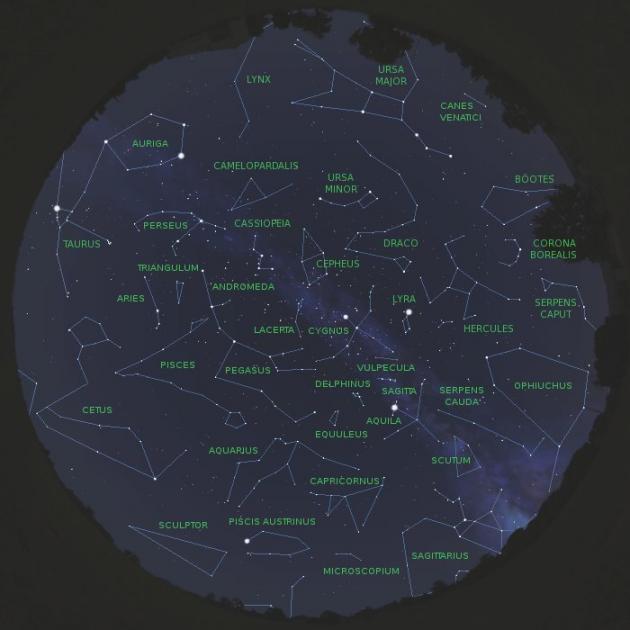- News / Thoughts
- Astronomy Guide
- On This Day
- Reviews
- Bookstore
Astronomical Events for October 2007
10/02/2007This month we can observe planet Jupiter for the last time this year. As far as observing planets goes, at least those on which we can observe some features, we're left only with planet Mars.
Although, as we're surely entering autumn season, the nights are getting longer, and longer, clock change to standard (winter) time, will increase our observing time by an hour. Most of Europe and Asia will be influenced by this, but USA will do the clock change next month.
With clock change, observing time can start earlier. As if that isn't enough, near the end of the month, the sky is giving us one more meteor shower - Orionids.
O

Evening sky for the middle of October 2007. at 09:00 PM. The map is valid for northern hemisphere, especially positions near 45 degrees latitude.
This month we'll lose planet Jupiter in the glow of the setting Sun. Although we've observed it for the last few months, this year Jupiter glided relatively low to horizon, and thus trying to use higher magnifications to spot some details in Jupiter cloud bands usually ended in frustration, since it resembled looking through the surface of a shimmering water. But all was not lost, since we could watch movements of Jupiter's biggest moons, exactly the ones which fascinated Galileo 4 centuries ago.
The only planet remaining with observing details is planet Mars, which will start to rise as early as 23:00h. To recognize even crudest details on Mars, you'll probably need to use highest magnifications on your telescope. One Mars day (a sol) lasts just a bit more then our on Earth, 24 hours and 40 minutes, so if you're willing to stay a bit longer, you'll be even able detect rotation of the red planet.
By the end of month on 21 'till 22 October, through Sunday night we'll be able to observe one less known meteor shower - Orionids. Our Moon is quite bright that night, but if you wait for midnight, it'll set down, giving us unobstructed viewing time until dawn. Expected frequency is about 20-25 of meteors per hour, and this meteors shower is known for fast meteors which leave trails. You may have already guessed by the name of this meteor shower that it's radiant is in the constellation of Orion. To be more exact, it's between the bright orange star Betelguese (the left shoulder of Orion) and planet Mars (which is also red) in the constellation of Gemini. While observing meteors, it is best to watch a bit away from radiant, and in this case it is best to look around winter hexagon (which was described in astronomical events for January).
Also at the end of this month, most of northern hemisphere will change back to standard (winter) time. On the last Sunday of the month, on 28. October at 02:00 o'clock in the morning, we'll turn back time for an hour. Thus we'll have longer night, which is the fact that most amateur astronomers won't argue against. You should be careful onwards when you calculate your local time from universal time, since you'll add one hour less. For example Central European Summer Time (CEST) has an offset of +2 hours from Universal Time (UT), while Central European Time (winter time) has an offset of only +1 hour. As of this year, USA will change their clock at different moment, which falls next month.
Let's end as usual with Moon phases for October 2007:
- Last Quarter - October 3. 10:06 UT
- New Moon - October 11. 05:01 UT
- First Quarter - October 19. 08:33 UT
- Full Moon - October 26. 04:52 UT